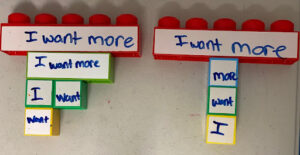There are two processes in which children learn language and both are typical. Analytic language processing consists of children learning/utilizing small units of language such as single words, then combining words into phrases, and phrases into sentences. Analytic language processing is referred to as a bottom-up approach to language learning.
Gestalt language processing consists of children learning/utilizing chunks of language also known as “gestalts” in which they then begin to break the gestalts down and can use single words and recombine these words into self-generated sentences. Gestalt language processing is referred to as a top-down approach. Children with gestalt language processing are often observed to script (say the same phrase over and over) and have echolalia (repeat what they hear), along with intonation within their productions. Gestalts are commonly acquired when they are deemed significant to the child, and no two gestalts are alike. It should be noted that not all gestalts are straightforward or literal, thus require further digging for the meaning behind them. A child’s gestalt could be “Happy Birthday” every time they feel happy or excited due to feeling happy on their birthday. It is important to remember that your child’s gestalt may carry a specific meaning behind it.
If your child scripts and appears to be a gestalt language processor, rather than focusing on stopping or correcting the scripting, model slight changes to their script to add in new details/information.
Example:
Current Gestalt: “I want more” while playing with play-doh
Model “I want more green/blue/red” to continue expanding on usage of colors/qualitative concepts.
Model “I want more squish/roll/cut” to continue expanding on usage of verbs.
Model “I want more big/small” to continue expanding on usage of qualitative concepts.
Visual:

(Left= Gestalt Language Processing; Right= Analytic Language Processing)
In the example above, the building blocks highlight the differences between analytic language acquisition compared to gestalt language acquisition. In analytic language acquisition learners, children often learn the smallest, most meaningful units of words (e.g., “want”) and slowly build up to phrases (e.g., I want) and sentences (e.g., I want more). Gestalt language processors do the opposite, they often begin internalizing and using whole phrases, sometimes as long as 5-6 words, but may not recognize that each word within the phrase is meaningful and can stand on its own (Blanc, n.d., pg 3). If a gestalt language processor qualifies for therapy services, therapy may incorporate helping them understand that their gestalts and individual words comprising the gestalts, have meaning. This is why modeling is so important. The more often words and phrases are modeled the more exposure children have to various gestalts or phrases to functionally express themselves.
Parent Resources:
https://www.youtube.com/@playtimewithtor
References:
Marge, B. (n.d.). The Natural Language Acquisition Guide, 2–39.
By, Mike Marcucci & Val Avendano
